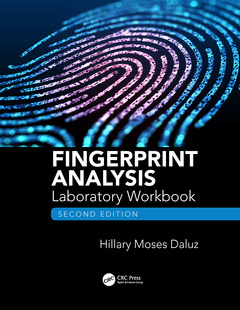Description
Fingerprint Analysis Laboratory Workbook, Second Edition (2nd Ed.)
Author: Moses Daluz Hillary
Language: English
Subjects for Fingerprint Analysis Laboratory Workbook, Second Edition:
Keywords
Latent Print; Fingerprint analysis; Friction Ridges; Fingerprint experiment; Fingerprint Powders; forensic science; Friction Ridge Impressions; forensic scientist; DFO; forensic laboratory; Black Fingerprint Powder; crime laboratory; Nonporous Item; criminalist; Latent Print Residues; latent prints; Latent Lift; crime scene technician; Latent Print Examiner; Part Iii; AFIS; Latent Fingerprints; friction ridge; Nonporous Substrates; ridgeology; Ridge Flow; loop; Alternate Light Source; arch; Porous Items; whirl; Evidentiary Items; inked fingerprints; Fume Hood; biometrics; Friction Ridge Detail; livescan; Fingerprint Identification; tenprint; VMD; ninhydrin; Friction Ridge Skin; crime scene; Rhodamine 6G; crime scene processing; Patent Prints; evidence; Follow; physical evidence; ACE+V; palm prints
Publication date: 11-2018
· 21x28 cm · Hardback
Publication date: 10-2018
· 21x28 cm · Paperback
Description
/li>Contents
/li>Readership
/li>Biography
/li>
Fingerprint collection and analysis may be performed as part of many jobs, including crime scene technician, latent print examiner, criminalist, and lab supervisor. Regardless of one?s specific background or role in the process, a knowledge of scientific practices is critical in handling and analyzing fingerprint evidence. The best way to understand the principles and concepts of any science learned in a classroom is to perform experiments.
The exercises in Fingerprint Analysis Laboratory Workbook, Second Edition address all aspects of fingerprint theory, investigation, processing, comparisons, and research. Designed specifically to parallel the Fundamentals of Fingerprint Analysis, Second Edition textbook, the laboratory exercises correspond with the textbook chapters, with exercise in the lab chapter putting into practice the concepts covered in the text chapter. Each lab follows the same format, beginning with the objectives of the experiment and providing the background information necessary to perform the experiment. This is followed by a list of required materials, the lab exercises, and post-lab questions for students to test what they?ve learned.
Many of the laboratory exercises may be completed either at home or in a laboratory setting.Exercises and photographs enhance the text, making it an ideal hands-on learning tool. New techniques and current practices added to the primary textbook have been included in this companion laboratory workbook to cover the latest in real-world application of fingerprint analysis science to practice.
Part 1. Introduction to Fingerprints 1. Introduction: Class and Individual Characteristics 2. History 3. Embryology and Physiology 4. Fingerprint Patterns and Classification 5. Known Fingerprints 6. The Nature of Latent Prints 7. Biometrics: Livescan and AFIS Part 2. Latent Print Development 8. Introduction to Processing Methods 9. Forensic Light Sources 10. Physical Processing Methods 11. Chemical Processing Methods: Porous Substrates 12. Chemical Processing Methods: Nonporous Substrates 13. Chemical Processing Methods: Other Substrates and Matrices Part 3. Fingerprint Analysis 14. Documentation 15. Crime Scene Processing 16. Fingerprint Comparisons: ACE-V Methodology 17. Fingerprint Comparisons: Point Counting, Error Rates and Statistics 18. Palm Print Comparisons 19. Courtroom Testimony
Hillary Moses Daluz is an instructor for Tri Tech Forensics and a Forensic Specialist with Forensic Identification Services. Daluz began her career as a Police Identification Specialist with the City of Hayward Police Department in Hayward, California. After earning her Masters of Science degree in Forensic Science from the University of California, Davis she deployed to the Joint Expeditionary Forensic Facility at Camp Victory in Baghdad, Iraq as a Latent Print Examiner. After returning stateside she became a member of the faculty in the Forensic Sciences program at Chaminade University of Honolulu. She then accepted a position as a Senior Latent Print Technician with American Systems. Daluz is a member of the International Association for Identification.




